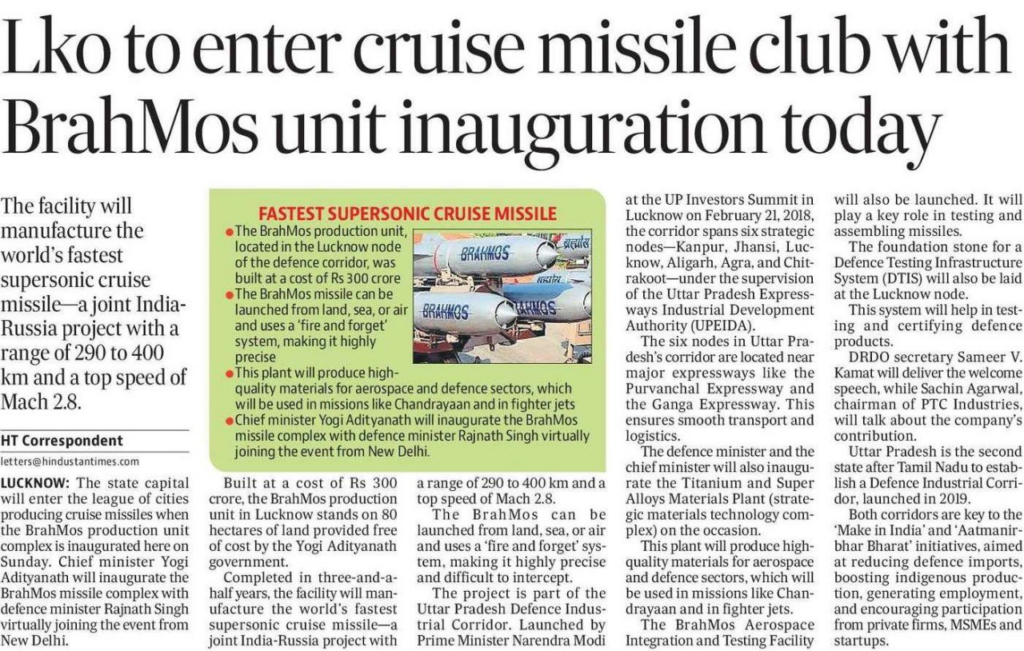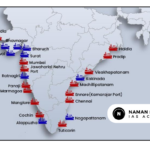NEW BRAHMOS MISSILE FACILITY LAUNCHED IN LUCKNOW
Relevance – GS2 International relations , GS3 Science and tech (defence) , prelims
CONTEXT – Successful use of brahmos in Operation Sindoor

ABOUT BRAHMOS MISSILE
- World’s fastest supersonic cruise missile.
- Jointly developed by: DRDO (India) and NPO Mashinostroyenia (Russia), which have together formed BrahMos Aerospace Private Limited.
- The name is derived from Brahmaputra (India) and Moskva (Russia).
Key Features:
- It weighs 3 tonnes (3000 kg) and measures 9 meters long.
- The air force variant is lighter (2.5 tonnes/ 2500 kg)
- Top speed: 2.8 Mach
- Range: 290 km now extended to 450 km
- Propulsion: Two-stage missile (solid propellant engine in first stage and liquid ramjet in second stage).
- Launched from multiple platforms, including land, air, and sea with pinpoint accuracy during day and night, irrespective of weather conditions.
- Fire and Forget principle of operation, difficult to intercept.
- Stealth technology and guidance system.
Export Potential
India delivered the first batch of BrahMos supersonic cruise missiles to the Philippines in 2024.

Examples of Other Cruise Missile
- Tomahawk: The United States Navy’s Tomahawk cruise missile is one of the most well-known examples. It’s used for long-range precision strikes and can be launched from ships and submarines.
- AGM-86 ALCM: The United States Air Force employs the AGM-86 Air-Launched Cruise Missile as a nuclear-armed cruise missile.
- Storm Shadow / SCALP: Developed by France and the UK, this air-launched cruise missile is used for precision strikes against high-value targets.
- Kalibr: A family of cruise missiles used by Russia, including anti-ship, land-attack, and anti-submarine variants.
- JASSM: The Joint Air-to-Surface Standoff Missile, used by the United States and several other countries, is designed for precision strikes against high-value, well-defended targets.
COMPARISON
| Parameter | BrahMos | Agni Series (Ballistic) | Nirbhay (Cruise) | Prithvi (Ballistic) |
| Type | Cruise Missile | Ballistic Missile | Subsonic Cruise Missile | Short-range Ballistic |
| Speed | Supersonic (Mach 2.8–3) | Hypersonic (Mach 5+ for Agni-V) | Subsonic (~Mach 0.7) | Subsonic– Supersonic |
| Range | ~450–800 km | Up to 5,000+ km (Agni-V) | ~1,000 km | ~150–350 km |
| Guidance | Precision navigation + seeker | Inertial + Satellite | Terrain hugging GPS | Inertial + Terminal guidance |
| Usage | Tactical & strategic, multi-role | Strategic deterrent | Strategic/Stealth penetration | Tactical battlefield use |
| Launch Platform | Multi-platform | Land-based | Land-based | Land-based |
CRUISE MISSILE VS BALLISTIC MISSILE
| Feature | Cruise Missile | Ballistic Missile |
| Flight Path | Flies within atmosphere, terrain hugging | High-arching path through space |
| Propulsion | Jet engine throughout flight | Rocket propulsion; follows free-fall trajectory |
| Speed | Subsonic to Supersonic | Supersonic to Hypersonic |
| Accuracy | High (can be guided till impact) | Moderate to high (depends on terminal guidance) |
| Detection Evasion | Difficult to detect due to low flight profile | Easier to detect due to high arc trajectory |
| Use Case | Precision strikes on specific targets | Strategic long-range strikes (nuclear capable) |
Strategic Significance of BrahMos
- Strategic Deterrence and Regional Superiority
- BrahMos enhances India’s strategic deterrence by offering a high-speed, precision-strike capability.
- It provides a credible counterforce option short of nuclear weapons.
- With China and Pakistan developing long-range missiles, BrahMos strengthens India’s second-strike and quick response posture.
- Technological Sovereignty
- Indigenous production of BrahMos components contributes to Make in India and Atma Nirbhar Bharat.
- It signals India’s growth in missile tech, propulsion systems, and guidance mechanisms.
- Multi-platform Capability
- Its deployment on INS Rajput-class ships, Sukhoi Su-30MKI, and mobile land platforms allows deep strike capabilities across all domains—sea, land, and air.
- The air-launched variant (from Su-30 MKI) has significantly expanded India’s strike envelope.
- Export Potential and Diplomacy
- India has exported BrahMos to the Philippines, marking its entry into global arms markets.
- Strategic defense cooperation with ASEAN and Indian Ocean Region nations is likely to grow.
- Weapon exports bolster India’s geopolitical influence and defense diplomacy.
- Challenges Ahead
- Need for hypersonic upgrades to stay ahead of emerging threats like China’s DF-ZF.
- Concerns over missile proliferation in South Asia.
- BrahMos is not nuclear-capable—it serves in a limited tactical-strike role.
PRELIMS PRACTICE QUESTION
Questions: Consider the following statements : (2023)
- Ballistic missiles are jet-propelled at subsonic speeds throughout their flights, while cruise missiles are rocket-powered only in the initial phase of flight.
- Agni-V is a medium-range supersonic cruise missile, while BrahMos is a solid-fuelled intercontinental ballistic missile.
Which of the statements given above is/are correct?
A. 1 only
B. 2 only
C. Both 1 and 2
D. Neither 1 nor 2
ANSWER – D. Neither 1 nor 2
MAINS PRACTICE QUESTION
Q. Evaluate the strategic significance of the BrahMos missile in enhancing India’s defense capabilities and strengthening its international defense partnerships. Discuss the key challenges India faces in further advancing the BrahMos program and expanding its global export potential







